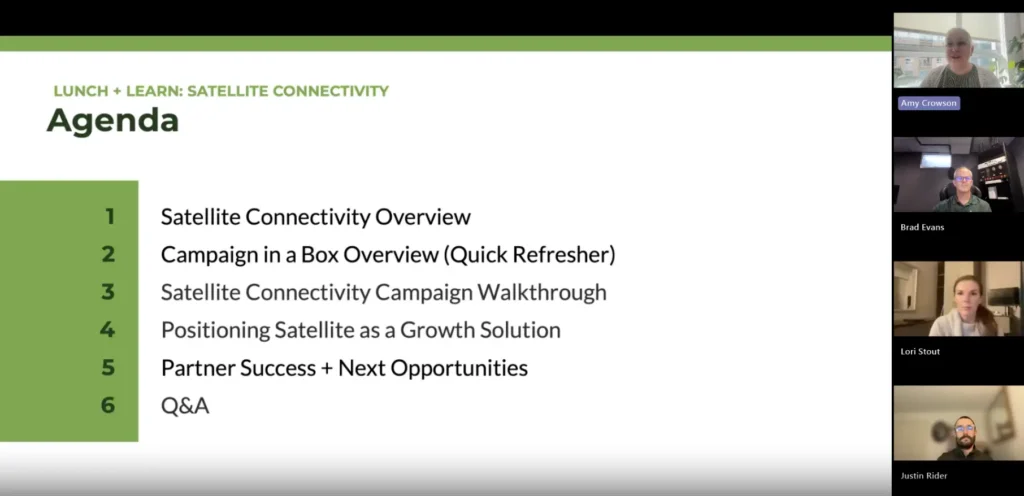In the past, going “off the grid” meant disconnecting. Today, even the most remote locations, from construction trailers to rural offices, are expected to stay connected and operational. Whether you’re managing a temporary site or keeping a distributed workforce online, satellite connectivity has evolved into a vital part of modern business infrastructure.
And at the heart of that evolution is the shift from GEO (geostationary orbit) to LEO (low-earth orbit) satellite technology.
Bridging the Gaps: From GEO to LEO
As Bigleaf Senior Sales Engineer Brad Evans explained during the Unlocking New Opportunities with Satellite and Bigleaf webinar, the earliest generations of satellite connectivity were built on GEO technology. These satellites orbit roughly 22,000 miles above Earth.
Providers like Viasat and HughesNet made broadband possible in places that fiber and cable couldn’t reach, but they came with a major drawback: latency.
“Prior to LEO, the only service offering out there was what we would call GEOSat… the latency became quite heavy and wasn’t quite suitable for modern communications.”
— Brad Evans, Senior Sales Engineer, Bigleaf Networks
That high latency, typically 600 milliseconds or more, made voice, video, and cloud applications frustratingly unreliable.
LEO satellites, by contrast, orbit just a few hundred miles above Earth. Networks like Starlink, OneWeb, and Project Kuiper use large constellations of small satellites to deliver fast, low-latency connections that are finally suitable for business-grade internet performance.
“Introducing LEO has brought latency down, has brought the viability down to the masses, and has really become a business continuity tool.”
— Brad Evans
Why Latency and Jitter Matter for Business Apps
For IT leaders and MSPs supporting UCaaS, CCaaS, and cloud-dependent environments, every millisecond counts.
Even small amounts of jitter (the variation in latency over time) can break up calls, drop meetings, or disrupt point-of-sale transactions. With LEO satellites, that risk drops dramatically, making it possible to deliver reliable performance for real-time apps even in rural or temporary deployments.
That’s why more businesses are adding services like Starlink to their connectivity mix. Not as a novelty, but as a primary or secondary path for uptime.
Pairing LEO with Terrestrial Circuits for Smarter Uptime
Of course, no single connection is perfect. The real power of modern satellite networks comes from pairing them with terrestrial circuits, and managing them intelligently.
Bigleaf makes this easy, automatically optimizing performance across all available links (fiber, cable, wireless, and satellite). Intelligent load balancing routes business-critical traffic where it performs best while managing bandwidth intelligently to avoid overages or throttling.
“With intelligent load balancing, you can pick and choose which circuits different types of traffic flow over.”
— Justin Rider, Senior Territory Channel Manager, Bigleaf Networks
That means your VoIP and UCaaS traffic can run over Starlink, while bulk data transfers or software updates stay on fiber, protecting both performance and data limits.
Real-World Scenarios Where LEO Excels
During the webinar, our team shared several use cases where LEO satellite connectivity delivers immediate value:
- Construction and temporary sites: Spin up connectivity in days, not months.
- Rural or remote offices: Extend network reach where traditional ISPs don’t go.
- Retail pop-ups and mobile units: Keep transactions and cloud tools running anywhere.
- Business continuity: Maintain operations during fiber cuts, outages, or disasters.
And when paired with Bigleaf, even complex deployments stay plug-and-play simple. No specialized configuration or IT expertise required.
“With Satellite and Bigleaf, you can deploy sites quickly and easily in a plug-and-play fashion.”
— Justin Rider
Where GEO Still Fits
While LEO is driving the next wave of business connectivity, GEO still has its place. Especially for non–real-time workloads like data backup, file transfer, or telemetry in ultra-remote regions. When configured with intelligent network policies, GEO can still serve as a viable last-resort continuity option for environments where every connection counts.
Pitfalls to Avoid
1. Ignoring Data Caps and Throttling
Starlink recently began throttling standard plans after 50GB of usage, slowing throughput or triggering high overage fees.
“Starlink actually just started throttling their plans to 50 gigs… but luckily with Bigleaf, you don’t have to worry about that.”
— Amy Crowson, Director of Partner Marketing, Bigleaf Networks
With proper traffic steering and prioritization, Bigleaf prevents wasteful traffic (like software updates or video streaming) from consuming valuable satellite bandwidth.
2. Treating Redundancy as One-Dimensional
Even two “different” internet connections may come from the same underlying ISP backbone, meaning both can fail together. Pairing LEO with terrestrial circuits provides true path diversity.
“They might have multiple connections, but it’s from the same provider… if their whole network goes down, so does the customer.”
— Justin Ryder
Beyond the Orbit, Real-World Reliability
In the end, the difference between LEO and GEO isn’t just altitude, it’s application viability.
LEO brings low-latency connectivity to places where reliable internet was once impossible. Paired with Bigleaf’s intelligent optimization, it transforms satellite from a “backup plan” into a core part of a modern, resilient network strategy.
For MSPs and IT leaders, that means new opportunities to deliver uptime, performance, and reach, from fiber-fed offices to off-the-grid cabins.

Turn Satellite Challenges into Sales Wins
Bigleaf’s Satellite Connectivity Campaign-in-a-Box gives partners everything they need to bring the Bigleaf + Starlink value story to market fast, including:
Co-branded sales sheets, infographics, and slide decks
A ready-to-deploy webinar kit (title, description, banner, slide deck, and speaker notes)
A four-part email series designed to address metered plans, remote-site challenges, and Bigleaf optimization
Social posts, companion videos, and industry-specific messaging
A complete deployment guide and recommended 4-week launch timeline
Whether you’re a one-person shop or a full sales team, this campaign equips you to capture satellite-driven demand, educate customers on metered-plan impacts, and win high-value deals in remote or bandwidth-constrained locations — all with less marketing lift.
See It in Action
Satellite connectivity isn’t just about getting online anywhere.
It’s about helping your customers get reliable, business-grade performance from Starlink and other LEO services—while giving you the edge to win more of those opportunities.
To learn more now, watch the on-demand webinar:

